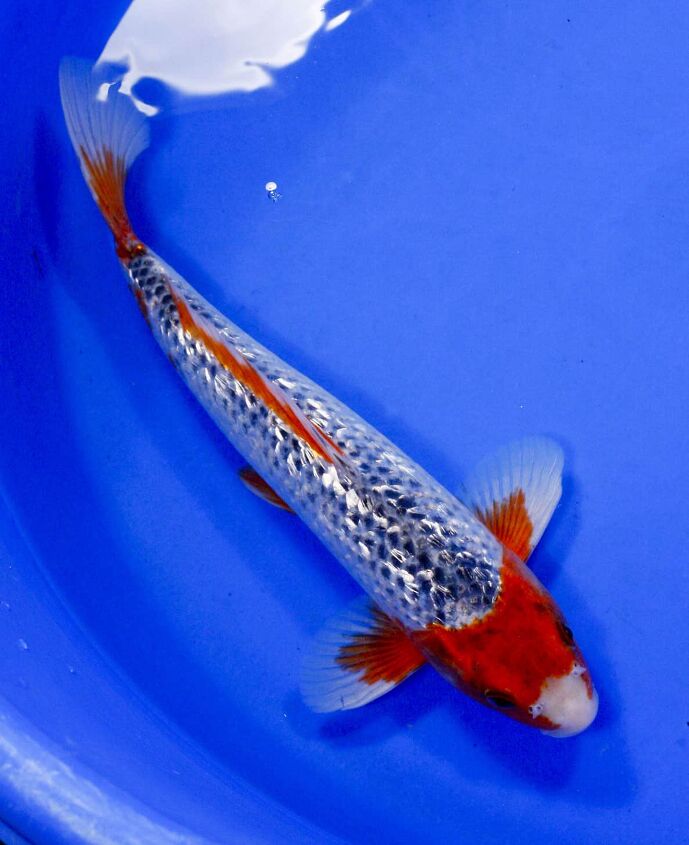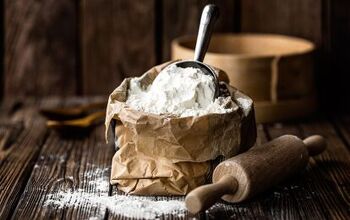15 Different Types of Koi Fish (with Photos)

Also referred to as Nishikigoi or jinli, Koi fish are colored variants of the Amur carp that most often serve a decorative purpose in outdoor ponds, water gardens, and even home aquariums. There are over 100 different types of koi fish that have been identified by the Japanese. Each variety has unique details for identification and can be described based on scales, patterns, and coloration.
The most common colors found in koi fish are red, black, white, blue, yellow, cream, and orange. Their striking color variations and unique patterns are what have made koi fish incredibly popular, giving life to whatever pond or aquarium they are found in.
Do You Need Pond Installation Services?
Get free, zero-commitment quotes from pro contractors near you.

15 Types of Koi Fish
With more than 100 koi fish varieties, you have many options to choose from. Some of the most popular include Kohaku, Showa, Tancho, Goshiki, Asagi, Bekko, and Goromo. We’ll take a look at 15 different types of koi fish, with the goal to help you reel in a winner that will dazzle your outdoor koi pond.
1. The Asagi Koi
The Asagi koi fish is one of the ancient varieties of koi. In the old days, they were considered to be a local delicacy for Japanese farmers until they began to realize their potential and beauty. If you’ve ever examined a koi pond or been among koi hobbyists, you’ve likely seen an Asagi koi fish. Asagi koi fish are characterized by an indigo or blue body, with red at the base of the pectoral fins. This red on the pectoral fins is referred to as Motoaka.
They have the common diamond-like scale patterns, red-hi- fish markings and are not metallic, meaning that don’t possess that typical sheen on their bodies. The Hi Asagi is a type of Asagi koi that tends to have more red on their bodies than usual. Whereas, the Taki Asagi has the usual blue-colored diamond-like pattern and red coloration with the addition of a white line of scales that sits between the red and blue areas on the body.
Regardless of the type of Asagi koi, the head is either white or pale blue, and free of any markings.
2. The Bekko Koi
The Bekko is another non-metallic type of koi fish that is solid colored, containing black (sumi) spots on the body. Bekki koi fish generally come in three main colors: red, yellow, and white. The white variation is referred to as the Shiro Bekko and is highly recognizable by its clean white body and black spots.
Whereas, the Ki Bekko koi has a yellow body with black spots and the Aka Bekko koi has an orange or red body and black spots. The former Ki Bekko is the rarest type. Bekko koi fish are often of the first types that beginner koi hobbyists learn to recognize and they are very commonly seen in Japanese water gardens and koi ponds.
The design on a Bekko koi fish, regardless of the primary color, is a simple stepping stone pattern. Their heads should be clear of any black markings, patterns, or spots. Although the Bekko is bred from the Taisho Sanke koi, they don’t have any Hi (red) markings anywhere on the body.
3. The Doitsu Koi
The Doitsu variety of koi is both beautiful and unique. Unlike many other types, the Doitsu koi does not have scales. The lack of scales gives Doitsu koi fish that famous metallic sheen. Though it’s an old variety, it can be considered a new variety in Koi history.
The first Doitsu koi came about over 100 years ago, but newer versions keep being developed since their scaleless feature can be crossed with nearly any variety. With the creation of the Doitsu koi, the number of Koi varieties almost doubled; for instance, Sanke and Doitsu Sanke, Kohaku and Doitsu Kohaku.
Since koi are a type of carp and carp is a food source in many areas of the world, the scaleless carp originated in Germany to make cooking easier. It was then imported to Japan in the early 1900s and became known as the Doitsu, from the German word “Deutsche.” Selective breeding of the Doitsu koi and the Asagi koi led to another addition to the koi family – the Shusui.
4. The Shusui Koi
The Shusui koi was one of the very first Doitsu varieties and is also one of the few blue-colored kois. They are essentially a Doitsu (scaleless) version of the Asagi koi. Because of the lack of scales on the body, there is no blue diamond-like pattern. By combining the Doitsu and Asagi, it resulted in a koi that has the coloring of an Asagi with only a single line of large scales down its back.
The striking colors, bizarre scaling, and symmetrical patterns make the Shusui koi fish one of the most unique and strange variations of koi fish out there. When selecting a Shusui koi for your personal collection, you want to look out for symmetry in the pattern of scales. Since they only have scales down the middle of their back, along the dorsal fins, a symmetrical pattern is ideal.
With the lack of scales throughout their body, the Shusui koi often has a very beautiful blue color. They also usually have HI marks on their fins, body, head, and cheeks, adding even more visual interest to this stunning koi variety.
5. The Goshiki Koi
The Goshiki koi was created in 1918 by breeding an Asagi koi with a Kohaku. The name Goshiki literally means ‘five colors’ in Japanese. It’s not exactly a fitting name for this type of koi, as you don’t often readily see five colors at a glance. However, this koi does display an array of colors, including blue, grey, and black. The colors appear in a netted pattern across a white and red Kohaku-like body.
With this type of koi, white is often the base color, blue and black make up the net-like pattern, and red-orange is found in the hi-plate. One major difference in the hi plate of the Goshiki and that of the Kohaku is that the former tends to be bolder, thicker, and have a more vibrant (almost neon) intensity.
The ideal Goshiki koi will have a clean fishnet pattern and no specs or black spots disrupting the appearance. The neon red-orange of the hi plate should be thick, with clean and crisp edges. Ideally, you don’t want to have any holes in the hi plate. Though, it’s okay for the pattern to be visible through it. As Goshiki koi mature, the hi plate will often thicken, and the fishnet pattern will show through much less (if at all).
6. The Tancho Koi
Aside from one prominent hi marking on the head, the Tancho koi is by no means a spotted variety. It is a simple, sleek fish that is known for the red spot on its head. Generally speaking, the Tancho is basically a Kohaku koi without all the markings on the body.
To be considered a Tancho variety, the defining red spot on the head must be symmetrical, whether it’s heart-shaped, oval, diamond-shaped, or circular. It must also be relatively large in size and not be speckled. Though there are different varieties of Tancho, they all have the same red pattern centered between the eyes on the head. Aside from the symmetrical red spot, Tancho koi also have a solid white base body.
7. The Kohaku Koi
Of all the types of koi fish, the Kohaku is considered as the king. Oftentimes, it is said that koi keeping begins and ends with the Kohaku koi. It was the first revealed to have two colors on its body and its patterns and colors were an incredible discovery among traditional koi rice farmers. Nowadays, the Kohaku koi remains a favorite.
Top-quality Kohaku koi fish will have the desirable Hi (red) markings on its made body, accompanied by a solid white color. In some cases, you’ll see a yellowish color on its snout, a feature that koi keepers either prefer or don’t care much about. The Hi markings found on Kohaku koi come in two main varieties. The first type has a subtle purple hue that does not fade with age, making it an important characteristic to have. However, the purple color tends to blur the edges of the hi markings.
The second type of Hi markings seen on the Kohaku koi is the most popular – red and orange hues. However, these types are harder to maintain. As the red and orange markings become more prominent, the quality of your Kohaku koi fish increases exponentially.
8. The Showa Koi
The Showa koi is also another popular type, commonly seen among outdoor koi pond owners. Also called the Nishikigoi, the ornamented Japanese koi carp, or Showa Sanshoku, the Showa koi is highly prized because of the well-balanced markings and dark red patterns. Sanshoku means ‘three colors’ in Japanese and the Showa gets this name from the presence of black, red, and white colors on the body.
Showa is a beautiful variety of koi and is considered one of the Gosanke, or Big 3, koi fish along with the Kohaku and Taisho Sanke koi. They are relatively similar to Sanke, with the main difference being the black-colored body of the Showa. The red and white markings also cover a large majority of the body.
A top-quality Showa will have well-balanced patterns and sharp edges between two color patterns. The white, black, and red markings will be evenly distributed, with crisp and clean spacing between each color.
9. The Goromo Koi
When compared to other types of koi fish, the Goromo receives slightly more adoration in both Japan and internationally. It is a cross-bred fish that is most known for its original koi scale patterns. Sometimes referred to as Koromo, the Goromo koi is a hybrid of the Asagi and Kohaku fish. It consists of the distinguishing net pattern of the Asagi and the typical colors of the Kohaku (red and white).
The body of the Goromo koi fish is a white color with a red and orange pattern throughout. What makes the Goromo koi different from the Kohaku is the blue-colored net pattern on each of the red scaly patches present on the body. The distinctive koi patterns on the Goromo koi make it easy to divide this variety into three different variants:
- Sumi Goromo: This variant is a black and white koi fish, which is relatively rare when compared to the other two options. It is an accidental breed, a mutation of the Goshiki koi fish. The word ‘sumi’ means black in Japanese, which describes the dark black markings that develop on the hi markings.
- Ai Goromo: The Ai Goromo consists of red and white patterns on the body. The distinguishing feature of this variant is the slight darkening of the edges of the scales. When the Ai Goromo is young the darker edges on the scales are slightly faint and as the fish ages, the patterns become more defined.
- Budo Goromo: The Budo Goromo shares a number of similarities in regards to features with the Ai Goromo koi. It can be described as a purple koi fish with dark red patterns on the edge of the scales, mixed with various blue markings. This results in a gorgeous purple hue.
10. The Ginrin Koi
The Ginrin koi is a variety that has diamond scales on the entire body, which are reflective. Its distinctive metallic sheen is one of the most attractive features of the Ginrin koi. These types of koi date back to the early 1900s and were first bred by Mr. Eizaburo Hoshino. Since then, there have been four variations of the Ginrin including the Beta Gin, Kado Gin, Daimond Ginrin, and Pearl Ginrin.
Generally speaking, the patterns and marking aren’t the distinguishing features of the Ginrin koi. Instead, the scales are the most striking features of this type of koi, determining the grade of the Ginrin koi.
When choosing a Ginrin koi, you’ll want to look out for sparkling scales that are even throughout the body – from the shoulders to the tails. To be considered a Ginrin, the koi should also have at least three rows of reflecting scales. Due to the limited production of this type of koi, you likely won’t see the Ginrin at a koi vendor.
11. The Taisho Sanke Koi
Also known as the Taisho Sanshoku or simply Sanke, the Taisho Sanke koi was developed from the Kohaku in 1918. The patterns found on this type of koi consists of three colors: red (Hi), black (Sumi), and white. In this variety, the size and location of the Sumi are especially important. Sumi, or black markings, on the shoulder (called Kata Zumi) is crucial for the Taisho Sanke koi. The overall balance of the Sumi is very important to this type of koi.
Though similar, you can tell the difference between the Showa and the Sanke because Sanke usually does not have black markings on the head. The head of a Taisho Sanke koi is often comprised of two colors – white and red.
When compared to the Kohaku koi, the red markings on Sanke begin at the top of the head, meaning the face is completely clear. In most cases, the pectoral fins are white at the base and contain few Sumi markings. Taisho Sanke is a part of the ‘Big Three’ in the world of koi fish.
12. The Kikokuryu Koi
This type of koi fish was created by breeding the Platinum koi with the Komonryu koi. It is essentially a metallic Kumonryu, a koi with gleaming Platinum skin and fins with profound Sumi (black) colors throughout. Aside from the striking metallic sheen, the Kikokuryu koi is known for its ability to change colors throughout the year.
In most cases, this type of koi is silver with black markings. However, the dark colors can spread and change, sometimes shifting to hints of blue. The change in hues may be caused by a number of factors including water temperature and lighting.
13. The Ogon Koi
The term ogon translates to ‘golden’ in Japanese. This type of koi is one of the most prominent among other varieties. Since the 1940s, the Ogon koi has been considered a visual commodity among koi hobbyists. It is a solid-colored metallic koi that ranges from gold to silver, shining gorgeously in a koi pond.
Nowadays, there are a variety of Ogon koi breeds, with the cream-colored variant being the rarest. The most popular type of Ogon koi is the Yamabuki Ogon, characterized by a bright yellow sheen. The platinum, or purachina, Ogon is another popular variety of Ogon koi.
14. The Kawarimono Koi
The Kawarinmono categorization consists of a variety of types of koi, specifically those that don’t have a specific trait to fall under another classification. In total, there are fourteen different types of koi that are within the Kawarinmono category including the Beni Kumonryu, Chagoi, Golden Crown, Midorigoi, Ginrin Ochiba Shigure, Soragoi, Karasu, Kumonryu, Karasu, Matsukawabakke, Shiro, Kawarigoi, Kigoi, and Hajiro.
These koi varieties are often understood as being less popular, however, that is a misconception. The many different types of koi that fall into this category make this group very unique. Significant features of Kawarinmono koi include non-metallic bodies, striking color patterns, consistent markings, and dark red hues. To be considered a high-quality koi, these features must be distinct and unfaded.
15. The Utsurimono Koi
The Utsurimono koi come from the same lineage as the Showa koi. They also have the same black skin and are divided into three categories based on the color of the interlacing markings: Ki Utsuri (yellow markings), Shiro Utsuri (white markings), and Hi Utsuri (red markings). Like the Showa koi, the Sumi in a Shiro Utsuri should cover most of the nose, pectoral fin joints, and side faces.
The Hi and Ki Utsuri will have yellow and red markings respectively in place of the white markings on the Shiro Utsuri koi. Generally speaking, the base of a Utsurimono koi is sumi (black), and utsuri means “reflection in Japanese.
Do You Need Pond Installation Services?
Get free, zero-commitment quotes from pro contractors near you.

Related Questions
How deep does a Koi pond need to be?
Generally speaking, a koi pond should be at least three feet deep, with over 1,000 gallons of water.
What types of fish can go in a pond with koi?
Usually, most types of koi fish can live in harmony with a variety of other aquatic creatures. For example, the koi fish and goldfish tend to co-exist well in a pond, in addition to the janitor fish. Another option is the lizard-like fish that eats the algae in tanks. These fish are docile and can work great in a koi pond.

Jessica considers herself a home improvement and design enthusiast. She grew up surrounded by constant home improvement projects and owes most of what she knows to helping her dad renovate her childhood home. Being a Los Angeles resident, Jessica spends a lot of her time looking for her next DIY project and sharing her love for home design.
More by Jessica Stone



























![How Much Weight Can a 4×4 Support Horizontally? [It Depends!]](https://cdn-fastly.upgradedhome.com/media/2023/07/31/9070333/how-much-weight-can-a-44-support-horizontally-it-depends.jpg?size=350x220)


![How To Reset A Whirlpool Cabrio Washer [In 5 Easy Steps!]](https://cdn-fastly.upgradedhome.com/media/2023/07/31/9076531/how-to-reset-a-whirlpool-cabrio-washer-in-5-easy-steps.jpg?size=350x220)









